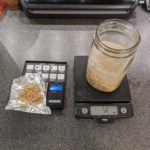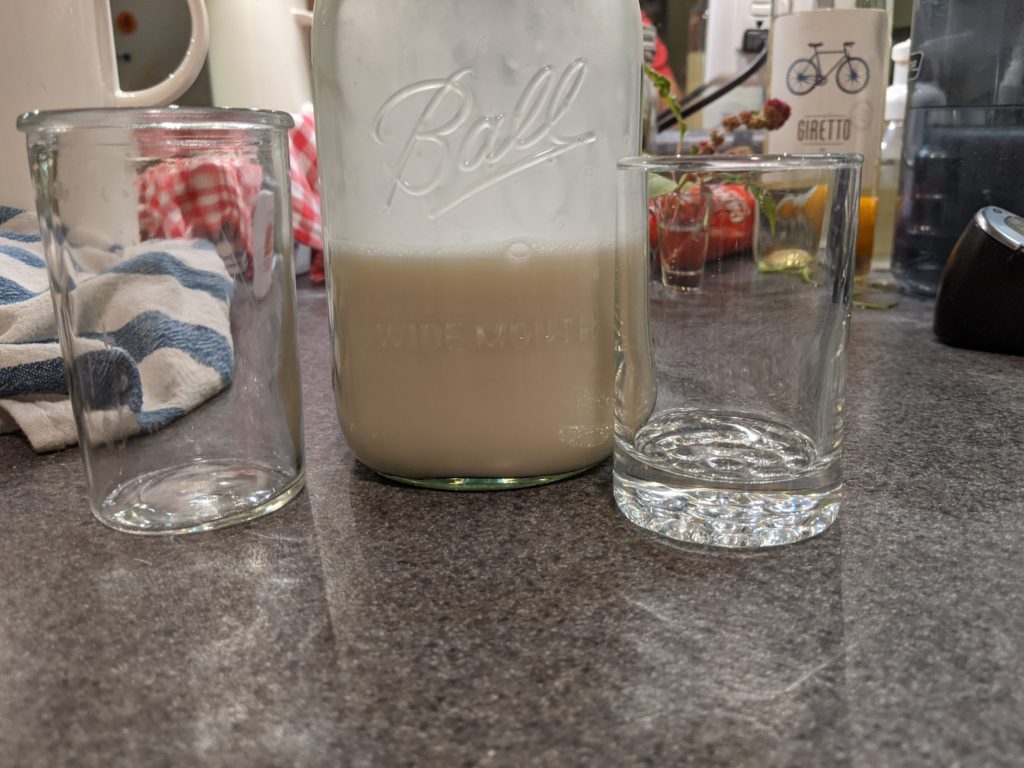Reverse Engineering Oatly: Part 2
May 14th 2020
Update: Don’t miss part three of the project!
I read all the Oatly patents (Sarah translated the Swedish one) and watched videos and read the whole Oatly website. The key piece of information missing from the previous recipe I made is that Oatly uses a couple of enzymes to convert starch in oats to sugars.

All of this oat research excited Sarah and we’ve been working together to design the perfect oatmilk. We want something slightly sweet, with the thickness of whole milk or cream, and it has to be great in coffee — no splitting!
The American Oatly patent has a sample recipe with huge quantities — in summary:
- Steam dehulled oats.
- Wet grind the oats at 129F (54C).
- Add water plus alpha amylase, beta amylase, and protein-glutaminase enzymes.
- Cook at 133F (56C) for 2 hours.
- Heat to 203F (95C) to deactivate enzymes.
- Cool to room temperature and decant.
- Dilute with water, then add oil, vitamins, salt, and various calciums.
- Pasteurize and package.
With the ingredients list from my previous trials and the patents we started to design a recipe.
We looked at using enzymes directly, but decided to try using malted barley. Malting grains make alpha and beta amylase. Plus malt is easy to get from brewing suppliers. (We do have some enzymes on order for testing too!)
Data from brewing charts suggests that we do a one hour cook at 148F (64C) for the beta-amylase, a second cook at 158F (70C) for the alpha-amylase, and at the end we bump the temperature up to 197F (92C) which denatures the enzymes. (We are using 197F/92C because that’s the max temperature of the immersion circulator we own.)
After a few trials we had a breakthrough when we found out about toasting the oats before processing them. It really lowers the oat smell and gives the resulting oat milk a light pleasant roasted flavor.
Our Current Recipe
This recipe compares favorably to Oatly, and is better than the other commercial oat milks that we have tried. We met all of our oat milk goals, but it could always be better, so we’re still experimenting. Watch out for updates.
This recipe makes a batch of about 17oz (500ml) after filtering and takes approximately 3 hours (which sounds long, but it’s mostly waiting).
| Ingredient | Grams |
|---|---|
| Water | 542 |
| Oats | 60 |
| Malted Barley | 6 |
| Canola/Rapeseed Oil | 18 |
| Salt | 0.8 |
- Pre-heat the immersion circulator bath to 148F (64C).
- Toast oats in the oven at 250F (121C) for 8 minutes.*
- Add oats and malted barley to water.
- Blend until fine; add mixture to a 1 quart (~1 liter) Mason jar.
- Put the jar in the water bath at 148F (64C) for 1 hour; shake the jar every 15 minutes.
- Increase the water bath temperature to 158F (70C) and cook the oat mixture for an additional 1 hour; shake the jar every 15 minutes.
- Increase the water bath temperature to 197F (92C). Once the water bath reaches temperature, wait 10 minutes to ensure that the oat mixture has come up to temperature too.
- Remove the jar from water bath and allow to cool to ~110F (43C). Temperature isn’t critical here, cool enough so you don’t burn yourself.
- Filter the oat mixture through a mesh kitchen strainer, and then through a reusable gold coffee filter.†
- Blend the salt and oil into the filtered oat mixture. If you see oil floating on top of your oat mixture blend more.
- Chill & drink!
*Depending on the kind of oats the toasting time might be different. We suggest doing a test toast of the oats that you’re using. Preheat your oven to 250F (121C), put some oats on a cookie sheet, and set a timer for 4 minutes. At 4 minutes open the oven grab a few oats, close the oven, and set your timer for another 4 minutes. Taste the oats; when they’re done they will have a hint of roastiness with no bitter/burnt flavor. Repeat until you figure out the perfect roasting time. Different brands of oats have required between 4 and 12 minutes. Instant oats seem to need longer, while fancier non-instant oats need shorter times.
†This filter combination seems to be sufficient; it doesn’t leave sediment in the oat milk and is much faster than paper coffee filters or kitchen towels. Protip: for faster filtering slowly run a spoon over the inside of the gold coffee filter move the filtered material out of the way.

